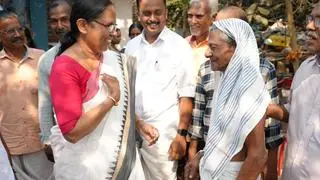The South West monsoon thus far has resulted in poor rains leaving most major reservoirs in a precarious situation in Andhra Pradesh and Telangana causing serious concerns in both States, needing contingency plans.
Both the States, who normally depend on monsoons to recharge ground water, fill up reservoirs, and use the water for hydel power generation, are keeping their fingers crossed over the much delayed rains.
According to the reservoir Storage Monitoring System, in Srisailam, the water level has dipped to 802 feet (current storage of 30 TMC) as against full reservoir level of 885 feet. Last year, the level was 880 feet with the storage of 190 TMC as against full storage capacity of 216 TMC.
At Nagarjunasgar, the level has dipped down to 510 feet as against FRL of 590 ft. It was 525 feet same day last year. As against full storage capacity of 312 TMC, it is now at 132 TMC.
Both these reservoirs on the Krishna river are not only dependent on the rains in the State, being lower riparian States, they bank on the rains in the catchment areas in Karnataka and Maharashtra. Once the dams there get filled, they release water downstream into these dams.
When these dams get filled up, they also serve as major resources for power generation. This enables the States to bring down overall cost of power generation while also ensuring additional supplies for about three-six months in a year. This year, the hydel generation too has been adversely impacted, causing more concerns.
Almatti, Narayanpur and Tungabhadra, are close to getting filled up. Once this happens, there could be inflows into AP, TS.
After rains for couple of days in the first week of June, there has been prolonged dry spell, resulting in extension of the summer months and severe water shortage.
The kharif crop season has been impacted. The recent directive of the Krishna Water Board that the water levels in the major reservoirs on the Krishna—Srisailam and Nagarjunasagar, are precariously low and adequate only to serve the drinking water requirements, has added to concerns of farmers in both the States.
Both the States have advised farmers to tread cautiously on water intensive crops following the Board advise. For farmers who have already planted saplings they are faced with withering crops.
The power tariff structure announced by the regulators also factors hydel power generation. However, with no generation, this could also impact the overall supply and possibly even the tariff for the year.
Both the States are banking on delayed monsoon to boost water inflows into these reservoirs, help the farm sector and also hydel power generation.
The situation in Godavari too is more or less similar with Sriramsagar and Nizamsagar yet to be filled up.







Comments
Comments have to be in English, and in full sentences. They cannot be abusive or personal. Please abide by our community guidelines for posting your comments.
We have migrated to a new commenting platform. If you are already a registered user of TheHindu Businessline and logged in, you may continue to engage with our articles. If you do not have an account please register and login to post comments. Users can access their older comments by logging into their accounts on Vuukle.